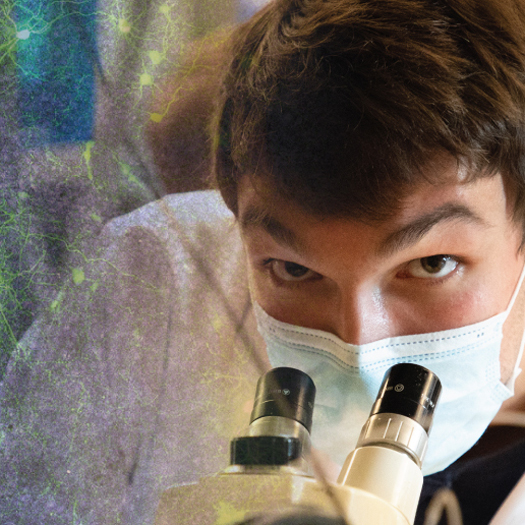NGP Faculty
Neuroscience Graduate Program (NGP) faculty are committed to mentor students pursuing BS/MS, MS or PhD degrees within their active lab groups that also include postdoctoral fellows, technicians, and undergraduate students. NGP faculty have strong records of funding from NIH, NSF and a variety of private foundations. Their research interests reflect the breadth and depth of the NPG and highlight the many exciting opportunities open to students. Prospective applicants should contact Dr. Kasper Hansen, who serves as the Director of the NGP and welcomes inquiries from interested students.
Michael Kavanaugh
Professor
Contact
- Office
- Health Sciences 308
- Phone
- (406) 531-3444
- michael.kavanaugh@umt.edu
- Curriculum Vitae
- View/Download CV
Personal Summary
Michael Kavanaugh is a Professor of Neuroscience in the Division of Biological Sciences. He completed undergraduate studies in biology at Washington University, graduate studies in biochemistry and biophysics at OHSU, and completed a neuroscience fellowship in the Vollum Institute at OHSU. He became a member of the Vollum Institute faculty in 1993, and moved to the University of Montana in 2003. He served as director of the Center for Structural and Functional Neuroscience from 2008-2016, and Director of the McLaughlin Institute from 2016-2021. He has chaired Gordon and FASEB neuroscience research conferences and served on Neuroscience, Biophysics, and Fellowship review panels for the National Institutes of Health. He is the recipient of over a dozen neuroscience research awards from the National Institutes of Health and was a recipent of a Klingenstein Neuroscience Fellowship and a Senior Wellcome Fellowship from Oxford University.
Education
BA, Washington University, St. Louis, MO
PhD, Oregon Health Sciences University, Portland, OR
Courses Taught
NEUR 481 Cognitive Neuroscience and Neural Networks
NEUR 491 Undergraduate Neuroscience Research
NEUR 661 Neuroscience I
Teaching Experience
Introduction to Neuroscience (NEUR 280) for undergraduates at UM (founded course)
Neuroscience I (NEUR 661)
Synaptic Transmission and Plasticity (NEUR 667)
Research Interests
In the brain, neurons communicate by synaptic transmission, which occurs when neurotransmitter is released into the synaptic cleft between two neurons. Glutamate is the major excitatory neurotransmitter in the brain, and when it binds to receptors on postsynaptic neurons, it activates signaling processes ranging from perception to learning and memory. GABA is the major inhibitory neurotransmitter in the brain and it plays a key role in modulating and opposing the excitatory glutamate signaling. Homeostasis, or long-term control of neurotransmitter actions, reflects a complex balance of synaptic release and reuptake of those neurotransmitters.
Research in Kavanaugh's lab has involved identifying and characterizing a number of transporters and channels. This work has helped reveal principles governing how the transporters for glutamate, GABA, and other neurotransmitters work, and how they cooperate with ion channels to regulate synaptic signaling in both normal and disease processes. With the human genome project nearing completion, the role of mutations and polymorphisms in many human neurological diseases is becoming apparent. In collaboration with academic and pharma partners, the team is also pursuing preclinical research using transgenic mouse models to develop and test new drugs including RNA-targeting synthetic oligonucleotides and engineered viruses.
Projects
The Kavanaugh lab is engaged in research directed towards understanding and developing therapies for neurological diseases that result from mutations in genes expressed in the brain. Many of these projects involve the use of transgenic mice that harbor mutations recapitulating human neurodegenerative diseases. These model animals are studied using behavioral, biochemical, and electrophysiological approaches. Several of these projects are focused on preclinical development of novel potential therapeutic approaches based on RNA targeting strategies.
Current projects include:
1) studies of the transporter for the major GABA transporter SLC6A1 and the mechanism of mutations that lead to autism and epilepsy
2) studies on the role of the recently identified D-serine transporter SLC1A4 and its role in homeostasis of NMDA receptor signaling in health and disease
3) studies on the mechanisms involved in Alzheimer's disease and genetic risk factors for disease
Field of Study
Neuroscience, neurophysiology and neuropathology
Selected Publications
Lyda et al. (2021) Discovery and synthesis of hydroxy-L-proline based blockers of the neutral amino acid transporters SLC1A4 and SLC1A5. BioRxiv https://doi.org/10.1101/2021.12.14.470456
Gnanaprakash, M. et al. (2021) Leucine carboxyl methyltransferase overexpression protects against cognitive and electrophysiological impairments in Tg2576 APP transgenic mice J. Alzheimer's Dis. 79 1813
Stainszewski, A. et al. (2020) Reduced Expression of the PP2A Methylesterase, PME-1, or the PP2A Methyltransferase, LCMT-1, Alters Sensitivity to Beta-Amyloid-Induced Cognitive and Electrophysiological Impairments in Mice. J. Neurosci. 40 4596
Minikel, E. et al. (2020) Prion protein lowering is a disease-modifying therapy across prion disease stages, strains and endpoints Nucleic Acids Res 48 10615
Foster, A. et al. (2016) D-Serine is a substrate for neutral amino acid transporters ASCT1 and ASCT2, and is transported by both sub-types in rat hippocampal astrocyte cultures. (2016) PLoS ONE
Sun et al. (2014) Glutamate transporter control of ambient glutamate levels. Neurochem Int 73, 146
Calderon et al. (2013) Early Alzheimer’s and Parkinson’s disease pathology in urban children: friend vs foe responses- it's time to face the evidence Biomed Res Int 161687.
Leary et al. (2011) The central cavity in trimeric glutamate transporters restricts ligand diffusion. Proc. Natl. Acad. Sci. U.S.A.108:14980
Otis et al. (1997) Postsynaptic glutamate transport at the climbing fiber-Purkinje cell synapse. Science 277:1515
Zerangue, N, and Kavanaugh, MP. (1996) Flux coupling in a neuronal glutamate transporter. Nature 383:634
Fairman et al. (1995) An excitatory amino-acid transporter with properties of a ligand-gated chloride channel. Nature 375:599
Affiliations
Neuroscience Program
Center for Structural and Functional Neuroscience
Center for Translational Medicine
Honors / Awards
1991 NIH NRSA Fellow
1993 Senior Wellcome Fellowship, Oxford University
2000 Chair, Gordon Conference on Membrane Transporters
2001 Klingestein Fellow in Neuroscience
2010 Co-Director, International School of Biophysics, Channels and Transporters
2016-21 Director, McLaughlin Research Institute
Hobbies
Kavanaugh enjoys the mountains of Montana and is an avid climber, skier, and fly-fisherman.

